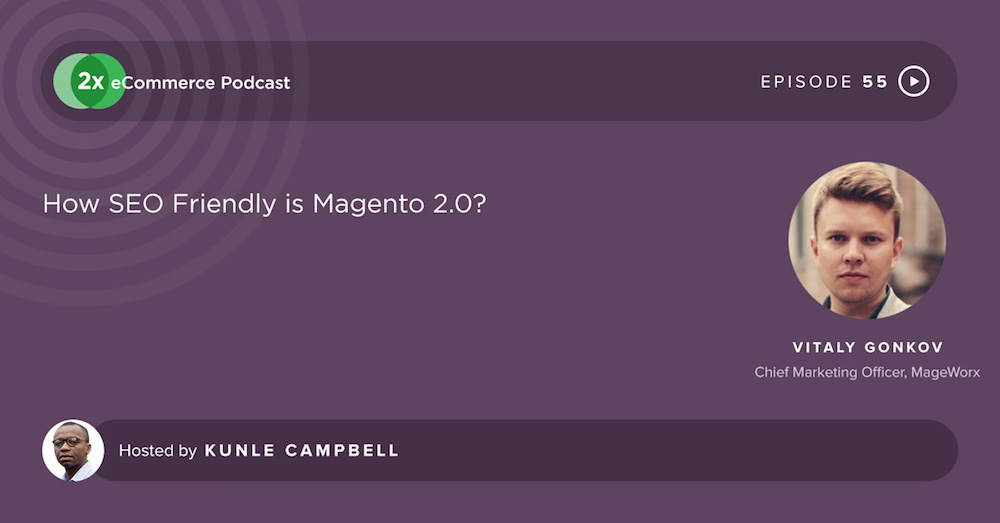
Podcast
Learn from Fast Growing 7-8 Figure Online Retailers and eCommerce Experts
How SEO Friendly is Magento 2.0? with Vitaly Gonkov, MageWorx
This episode of of 2X eCommerce Podcast Show continues our exploration of the new Magento version 2.0 and joining me is Vitaly Gonkov, the Chief Marketing Officer of MageWorx. Now if you run a Magento website you would no doubt have come across MageWorx and their Magento extensions and in my opinion they offer the best Magento SEO Suite software out there. So Vitaly is here today to run us through the core technical SEO features and aspects of a site that is expected to run on the upgraded Magento platform version.
We outline the key improvements from and SEO standpoint, inclusive of product page optimization, category page optimization, sitemaps, and schemas. Vitaly outlines what’s new, what’s carried forward, what needs improving, and how MageWorx is filling the gaps. This episode is essential for anyone with a Magento site who is looking to see how the new version of the platform can be expected to improve their SEO and make website pages stand out in search results.
SEO Improvements and Product Page Optimization:

Key Improvements: From an SEO perspective the biggest improvements in the new version are:
- The ability to add rich snippets and organize structure markup data
- The ability to optimize search engine indexation by editing robots txt files from the admin panel
- A more complex and extensive set of tools and options for optimizing category pages.
1: Product Fields Auto-Generation
The most important SEO elements of any product page are it’s meta-title and H1 tag, being as a rule, it’s the product name. Also, meta-data is important and so despite the fact that Google has devaluated some importance of this type of data, it’s still important to have unique meta-product descriptions and word duplication of meta-keywords.
The most important SEO elements of any product page are of course it’s meta-title and H1 tag.
One of the biggest new features that Magento 2 has introduced is Product Fields Auto-Generation. This new feature assists with the creation of product meta-text using the available product attributes. However there is a downside: this feature changes meta-text for all products as it uses only one template.
And so MageWorx is currently working to develop advanced SEO meta templates for Magento 2 and that should be available in two or three months as part of our SEO Suite Ultimate extensions, allowing users to assign different templates to different products.
Previous Features Carried Forward to Magento 2:
- Ability to set up canonical meta-text for your product
- Ability to create SEO-friendly URLs by including category paths for product URLs
2: Category Page Optimization

Category Page Optimization: When it comes to category page optimization, it’s vitally important to set up canonical URLs rightly. The point is that a lot of duplication can be caused by layered navigation. Hence, every website owner should take better control of it.
When it comes to category page optimization, it’s true, it’s vitally important to set up canonical URLs rightly.
- Layered Navigation feature in Magento gives customers a comfortable and efficient way to search store catalogue. The drop-down list to filter for attributes can be by product price, color, brand, or whatever different attributes it can actually find.
- URL Preservation: This is a small little quite useful improvement new and unique to Magento 2. The URL Preservation feature gets rid of the query parameter URLs so whatever you sort or arrange categories using the available filter options, the category page URL will remain basically the same and won’t include URL parameters as limit, sort, and mode. This will take care of a lot of canonical issues on category pages
3: Sitemaps
On the one hand Magento has massively improved it’s default XML sitemaps. And on the otherhand, there is no HTML sitemap at all.


XML Sitemap Improvements:

- Ability to separately specify the frequency and the priority of each page. It can be either a product page or category page or CMS page.
- Ability to automatically add the XML sitemap to your robots.txt file and edit it via the admin panel.
- Ability to add images
- Ability to use the Sitemap Index and allow you to define different parameters on splitting items between XML files.
Schemas:

Magento 2 has an impressive set of tools for optimizing structure markup data. It’s now possible to make your pages stand out in search results by displaying such attributes as rating stars, price, currency and even the product image, which is a kind of surprise for me. Because it’s very rare when you can actually see product image in rich snippets.
Magento 2 has an impressive set of tools for optimizing structure markup data.
This feature is enabled in the system by default, so you don’t need to go through the site and then configure it. So on the one had it’s of course cool because no technical knowledge is required. But on the other hand if you would like to configure it somehow then there’s no way to do that now.
4: How MageWorx Fills the Gap

Our extension lets users generate fully-fledged, fully-functional HTML sitemap so they could add any pages, exclude any pages, set different HTML segment criteria, and so on and so forth.
- Our extension helps to produce more SEO-friendly URLs. For now Magento still has some spots you know in this and that is why our extension helps to produce more SEO-friendly URLs for product pages and category pages.
- Upcoming Extension Support for:
- SEO meta tag templates
- Open Graph and Twitter Cards
- Magento Areas of Expected Further Improvement: I believe that they will make some fixes of the features they have just released because you know that some features that we were talking about, for example Product Field Auto-Generation feature, it still doesn’t work properly. Also I believe that they will add some sort of HTML sitemap, maybe it’s a basic version but it nevertheless will be useful for Magento users.
Key Takeaways
(02:10) Introducing Vitaly Gonkov
(05:34) SEO Improvements and Product Page Optimization
(12:35) Category Page Optimization:
(16:27) Sitemaps
(19:01) Schemas
(20:48) How MageWorx Fills the Gap
Transcript
Kunle: Hello 2Xers, welcome to the 2X eCommerce Podcast. I’m your host Kunle Campbell and today is another Magento 2 special. This time I’m being joined by Vitaly Gonkov. He is the Chief Marketing Officer of MageWorx. Now if you run a Magento website you would no doubt have come across one or two or maybe even a few of their plug-ins or extensions, Magento extensions. I mean I’m just on the website now, they have Magento extensions for order management, SEO, advanced product options, file downloads, store currency. I personally, from consulting I rendered for clients, have used and always recommend their SEO Suite Ultimate because in my opinion it is the best Magento SEO Suite software out there. Now the reason I got Vitaly on the show is to take us through the SEO features, the core technical SEO features of Magento 2. As you know or as I’ve said previously, there are kind of 3 core pillars in getting more search engine visibility or SEO visibility in your stores. And the three are technical SEO: making sure you’re compliant with Google and other search engines. That compliance is really importance, which sticks together with your keyword research and your architecture. Then the second is your user experience: making sure people stay on your site when traffic is sent down your way because if there’s a high bounce, what happens? Google sends less traffic down your way. And the third is brand building and content marketing. So Vitaly’s here to talk about the first aspect, the technical SEO aspects of a site that runs on Magento, well that’s expected to run on the Magento 2 platform. Without further ado I’d like to welcome Vitaly to the show. Welcome to the show, Vitaly.
Vitaly: Hello Kunle. Thanks for inviting me to the show.
Kunle: You’re welcome, you’re very, very welcome. It’s great to have you and you guys there. So what are you guys working on Magento… what are your thoughts on Magento 2 by the way?
Vitaly: Well I know currently a lot of work is going on. We’re working hard to produce more and more Magento 2 extensions. Also we are currently working on SavvyCube 2.0, so it’s going to be a new version of our and SAA-based software for Magento analytics and also we’re currently improving our existing Magento 1 extensions.
Kunle: That’s very, very interesting. I mean you guys been around 2008 and in the last seven years what you’ve managed to achieve has been amazing. So this SavvyCube… is that correct? SavvyCube, what’s it about?
Vitaly: Yeah, so basically it takes data from three different sources: it has Paypal, it has Magento and it combines it all together in a beautiful analytics graphics so you can easily analyze all your store revenue, refunds, and other stuff.
Kunle: Okay. That is interesting, it’s almost like a dashboard four for Magento stores.
Vitaly: Correct.
Kunle: Nice one. So we’re here to talk about your thoughts on how… I think the topic here today is how SEO friendly is Magento 2.0? And I’ll start out with your thoughts on how does Magento 2 compare to Magento version 1 from and SEO standpoint?
Vitaly: Well you know Magento 2 has definitely more complex technologically. You know that PHP technology and landscape has significantly changed over the last years and Magento managed to react to these changes and accumulate and observe the best ones. Talking about the SEO perspective you know the Magento team has done a really big job to make the second version of the platform as user-friendly as the first one. And they also managed to introduce a number of significant improvements. In my opinion the biggest ones are the ability to add rich snippets and organize structure markup data, the ability to optimize search engine indexation by editing robots txt files. And the next one, I believe it’s a more complex and more extended set of tools for optimizing category pages. So basically these three things I consider is the biggest case of improvements of the new version of the platform.
Kunle: Okay that’s very, very, very interesting. So one’s rich snippets and you know that semantics, making sure the semantics and on-page semantics are really good. I didn’t know about the robots text edit… so you can now edit robots text directly in the Magento dashboard?
Vitaly: Yeah, and you can manage to try it from the admin panel.
Kunle: Okay and the third you said was the advanced options on category pages, that is very interesting. We’re going to be talking in more detail into every one of these aspects you’ve brought to our attention. Okay, I will go with the flow from the funnel, right. From an SEO standpoint, well, from a funnel standpoint the last bit of your funnel is your checkout, right? And there’s really no SEO on the checkout, so let’s start out with product pages, on product page optimization. What do you think are the most important SEO elements on product pages and how does Magento 2.0 stack up to these important elements on product pages, SEO elements on product pages?
Vitaly: Ah well, the most important SEO elements of any product page are of course it’s meta-title and H1 tag. As a rule, it’s a product name. Also, meta-data is important. You know that despite the fact that Google has devaluated some importance of this type of data, it’s still important to have unique meta-product descriptions word duplication of meta-keywords. And actually Magento 2 can be of some help here. You know that they introduced a new feature, it is called Product Fields Auto-Generation. And it [inaudible 00:06:47] to form a product meta-text using the available product attributes. The only disadvantage we have of this feature is that it changes meta-text for all products using just one template. And this is the place where we can actually help. Now we’re working on developing advanced SEO meta templates for Magento 2. Hopefully it’s coming in two or three months. And these templates will be part of our SEO Suite Ultimate extensions and users will be able to assign different templates to different products.
Kunle: Okay, just so I got what you just said, right, so there’s kind of like a product template for your title and your meta-description tags. And what you’re saying in essence is Magento 2 has just support for a single template that will just cascade all through your entire catalog.
Vitaly: Right.
Kunle: And there’s no option for flexibility, so I can’t say products that are in this particular category should inherit this template structure and you know, those that are in this other category should inherit this structure or this template. So with the extension, with Ultimate SEO Suite extension you are able to more granularly select templates and apply templates on pages that are tagged in the setting or however you want to do, there is much more flexibility basically to adjust templates… is that what you’re…?
Vitaly: Yeah, that’s what I’m talking about.
Kunle: Okay, okay. Well that is really, really, really interesting. In Magento 1 was this the case or is this an improvement or is this just been kind of like the same as Magento 1?
Vitaly: You’re talking about our extension, right?
Kunle: No, the product title template.
Vitaly: Yeah, basically it’s the same. But this new feature, Product Fields Auto-Generation, is actually a new one. So there was no such functionality in the previous version of Magento.
Kunle: Okay, okay, interesting, very, very interesting. Now, what about canonical tags on product pages? This occurs… a lot of times you could have you know maybe 10 product pages pretty much selling the same thing but in different colors and you want to singular version, or singular URL, which you want the search engines to serve on their result pages. So how does Magento 2 allow for product page canonical tags?
Vitaly: Well you know, basically in Magento 2 can set up canonical meta-text for your product the same way it was in Magento 1. So if it had a long URL with different parameter, you can enable this feature, this function, and such URL will be referred to at product URL. So basically nothing new here, the same functionality was just transferred from Magento 1 to Magento 2.
Kunle: Okay, okay, okay. Nice one. What about product page URLs? Any changes there or have there been any improvements Magento 2?
Vitaly: Actually, no. With Magento 2 you can create SEO-friendly URLs by including category paths for product URLs. There’s the same functionalities in Magento 1, it just replicates the settings from the previous version.
Kunle: Okay, okay, okay. Interesting, very interesting. Going back to product pages, are there any other SEO features I should be aware of in Magento 2?
Vitaly: I believe no. The biggest one was the Product Fields Auto-Generation feature and other functionality has remained basically the same.
Kunle: Okay. Right, what about category page optimization? What do you think are the most important elements on category pages and how does Magento 2 stack up?
Vitaly: Okay, the most important SEO elements are with product pages its title and H1 tag. Also when it comes to category page optimization, it’s true, it’s vitally important to set up canonical URLs rightly. The point is that a lot of duplication can be caused by layered navigation. Hence, every website owner should take better control of it.
Kunle: Okay, let’s step back and for those of our listeners who are not aware of the concept of layered navigation. What exactly is layered navigation?
Vitaly: Generally speaking layered navigation feature in Magento gives customers a comfortable and efficient way to search store catalogue. They’re list down with special filters for different attributes that can be product price, color, brand, so whatever attributes it can actually find. And basically it is for fields through local links to pages to point them to these criteria and it’s located on the left of category pages.
Kunle: Yeah, that filtering ability which is so important in e-commerce. You know I bang my head when filters are not done properly on sites. And the case used to be we would you know, when you filter through you have query parameter, URLs generated, URL parameters – the question mark, color equals this, size equals blah blah blah. But I came across an article, your article actually, your article on Magento 2 SEO features. That’s actually what triggered this conversation with you. And you talked about the URL preservation feature which gets rid of the query parameter URLs. I really like the idea. Is this a native Magento 2 feature now? That URLs are just the way they are and then you could filter find?
Vitaly: Yeah, it’s totally unique to Magento 2. Magento 1 doesn’t have such an option. And I know it’s a little but quite useful improvement of the new version of their commerce platform. Now, whatever you sort or arrange categories using the available filter options, the category page will remain basically the same. What I mean is that it wouldn’t include such URL parameters as limit, sort, mode and stuff like that.
Kunle: That is huge, that’s a huge improvement. Because some etailers have hacked this using Ajax and now it’s default and you know that would…do you think it’s going to take care of a lot of canonical issues on category pages?
Vitaly: I believe yeah.
Kunle: Okay, that’s very interesting. Okay, so is there any other feature, SEO feature on category pages listeners should be aware from Magento 2?
Vitaly: Actually no, the rest of the functionality remain the same, for example talking about pagination on Magento 2 sets canonical tag on pagination pages to point to the category itself. So the same feature was in Magento 1. So basically yeah, the other features they were just transfered from Magento 1 to Magento 2.
Kunle: Okay, okay. Let’s talk about sitemaps. Does Magento 2 adequately handle XML sitemaps and HTML sitemaps for SEO?
Vitaly: Well you know, yes and no. On the one hand Magento has massively improved it’s default XML sitemaps. And on the otherhand, there is no HTML sitemap at all.
Kunle: Wow.
Vitaly: So that’s a kind of disadvantage. But talking about an XML sitemap, you know there were a lot of positive improvements. For example, now you can separately specify the frequency and the priority of each page. It can be either a product page or category page or CMS page. Also with Magento 2 you can automatically add the XML sitemap to your robots.txt file and edit it via the admin panel. And in addition it has become actually possible to add images and use the Sitemap Index, which is kind of good.
Kunle: Oh, okay.
Vitaly: Yeah, because it lets you define different parameters on splitting items between XML files and make it full compliant physical requirements.
Kunle: Wow, that is big, especially the sitemap index, the support for image in sitemaps. Very, very good points. I’m a bit surprised that they’ve lost support for HTML sitemaps, which is interesting. One key question I have is can you split sitemaps by page type?
Vitaly: Well actually we have not analyzed this feature because you know…actually while analyzing Magento 2 we haven’t found this feature but I believe maybe it will be added in one of the coming versions of the platform.
Kunle: Okay, because to me it’s so important to… Any technical SEO project that I view or I am part of, I just tell the clients, ‘You need to hack this.’ There’s some plug-ins out there that I think can split it by maybe category. Because if like you have an indexation issue and you are trying to troubleshoot you know, splitting out your sitemap is so important. So you just drill down into the sitemap, to each and every sitemap type, and see where the biggest drops in indexation is when you go into Google search console.
Vitaly: Right.
Kunle: Yeah, it’s interesting. It would be great if they could allow the support for the split of XML sitemaps. Okay now let’s talk about the last bit which I found very, very interesting. Which you were talking about the support, the native support for Schema.org markup. Exactly what schemas does it cover? Could you shed some more light here, please?
Vitaly: Yeah, sure. As I said before Magento 2 has an impressive set of tools for optimizing structure markup data. Now it’s possible to make your pages stand out in search results and make them more noticeable by putting them with such attributes as rating stars, price, currency and even the product image, which is a kind of surprise for me. Because it’s very rare when you can actually see product image in rich snippets. But Magento nevertheless offers this so soon we will see how it works. And one more thing is that this feature is enabled in the system by default, so you don’t need to go through the site and then configure it. So on the one had it’s of course cool because no technical knowledge is required. But on the other hand if you would like to configure it somehow, no, there’s no way to do that now.
Kunle: Wow. That is massive and it kind of shows the importance of structured data now on the web because if you can break down the contents of the page in bits and label them as bits of data then you can start to get websites to talk to each other and you could get Google to understand your website much better. It is impressive, but I wish they would allow you to tinker around with the code. Yeah, I see what you mean. Okay let’s finally wrap up in terms of how does MageWorx, your Ultimate SEO extension, fill-in the gaps? Let’s identify what the gaps are. Could you outline the gaps and how MageWorx actually fills those gaps, please?
Vitaly: Yeah, first of all talking about sitemaps, our extension lets users generate fully-fledged, fully-functional HTML sitemap so they could add any pages, exclude any pages, set different HTML segment criteria, and so on and so forth. So this is the first gap we have already filled. Also our extension helps to produce more SEO-friendly URLs actually. For now Magento still has some spots you know in this and that is why our extension helps to produce more SEO-friendly URLs for product pages and category pages. Also now we’re working on SEO meta tag templates so they will be added pretty soon. And one more point that we’re going to add, it’s the support of Open Graph and Twitter Cards. You know for now unfortunately Magento can be of no help with this.
Kunle: That is really, really interesting. Okay so from your perspective where do you think Magento’s going to make the biggest improvements from an SEO standpoint in the next versions on Magento 2?
Vitaly: Well, I actually believe that they should make some fixes of the features they have just released because you know that some features that we were talking about, for example Product Field Auto-Generation feature, it still doesn’t work properly. So they should fix it somehow. Also I believe that they will add some sort of HTML sitemap, maybe it’s a basic version but it nevertheless will be useful for Magento users. And to keep working on improvements of the platform as a whole.
Kunle: Okay, brilliant, brilliant. And just for our listeners that are not aware of MageWorx and the kind of stuff you do, exactly how many SEO extensions in Magento have you guys on offer?
Vitaly: Well, currently have a range of SEO extensions. So they can help in different aspects of Magento website optimiztions. So that includes rich snippet optimization, cross-links, generate SEO meta tag templates to optimize metadata [inaudible 00:22:46]. Also we have Sitemap Suites that helps to generate different types of sitemaps such as XML and HTML. And also more extensions are coming in the near future so just stay tuned and check up for dates on our website and you will learn everything.
Kunle: Okay. And for our listeners, if you head over to MageWorx.com they have under their extensions tab if you scroll down on the left, there is SEO tools. It’s quite extensive, I have to say, Vitaly. I will link to it from the show notes. Yeah so we’re going to wrap this up but before you go are the any resources or websites or books around Magento and SEO you’d recommend to our listeners, please?
Vitaly: Well, that’s kind of a tricky question. I believe actually there is no such books right now, because I personally haven’t seen any on that. All information we take, it’s from Magento forums and different stuff like that. But maybe…you know something about it?
Kunle: No, no, not at all. You’re the second person saying this actually, we had a Magento 2 Roundtable and you know, there are no books. It just seems to be the forums and you know blogs and that’s it really, in terms of expanding knowledge. I think that they said they put… there’s some documentation for Magento also.
Vitaly: Yeah.
Kunle: So it’s interesting. It’s been an absolute, absolute pleasure having you on the show, Vitaly. How can listeners get in touch with you if they wanted to?
Vitaly: Well they can follow me on Twitter. So my Twitter name is vital_i_am. And they can also follow me and add me to their friends list on LinkedIn, so ‘Vitaly Gonkov’.
Kunle: Okay I will link to your social media handles from the show notes. It’s been an absolute pleasure speaking with you, thank you.
Vitaly: Thank you for having me.
Kunle: All right, cheers, bye-bye.
Vitaly: Bye-bye.






